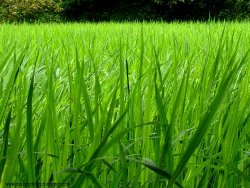 In the backdrop of deficient rains that have threatened rice output, agriculture scientists at the Punjab Agricultural University are working on developing a new variety of paddy that would consume less water compared with the traditional variety.
In the backdrop of deficient rains that have threatened rice output, agriculture scientists at the Punjab Agricultural University are working on developing a new variety of paddy that would consume less water compared with the traditional variety.
The new, less water consuming variety of paddy will be developed using conventional breeding and biotechnology techniques.
"We have initiated research for developing a new variety of paddy whereby we will increase the usage of water efficiency in the new crop variety," PAU's School of Agriculture Biotechnology director S S Gosal told PTI today.
Although, it may take at least five years to develop the new variety but it will reduce the dependence of paddy on rainfall or irrigated water to a large extent, experts pointed out.
Experts have termed paddy as a water-guzzling crop that has put a lot of pressure on the underground water resources mainly in central districts of Punjab.
Because of scattered monsoon this year, paddy growers in Punjab and Haryana are spending large amounts of money on diesel for watering the crop as paddy requires standing water to grow.
Gosal said the scientists are undertaking research activity on the project 'Genetic Engineering of Rice for Greater Water Efficiency', funded by the department of biotechnology.
"Under the genetic engineering technology, efforts will be laid on studying genes which have the properties of consuming less water like Gly, Dreb and Zad and then combinations would be made to develop a new gene that will be further transferred the into traditional crop variety," he said. A similar technique is being used for maize as well.
In addition to this, the department is also using conventional breeding techniques under which the germplasm of a traditional rice crop grown on hilly areas would be used to develop a new variety.
"We have observed that rice grown in hilly areas requires less water as standing water practice can't be used by paddy growers in those areas because of topography," he said.
The germplasm of this variety can be used in the traditional paddy variety like PAU 201 which will consume less water.






 © 2025
© 2025